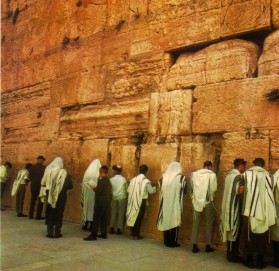| A
community marked by mystical renewal, persecution, the emergence of
the state of Israel, and diversification into orthodox and secular
forms. |
 |
|
Prayer
at the Western Wall in Jerusalem
|
Mystical trends
in Judaism
of earlier periods continued in the eighteenth century. Rabbis such as
the Baal Shem Tov formed circles of followers who sought ecstatic experience
and special insights into divine life. These groups, known as "Hasidim,"
adopted distinctive dress such as black coats, fur or felt hats, and long
strands of hair along their ears.
In the nineteenth
and twentieth centuries some European countries sought to strengthen their
national identities and engaged in violence against the Jewish minorities.
Severe persecutions occurred in Russia and later under Nazi rule in Germany,
when six million European Jews were killed between 1933 and 1945. Many
Jews emigrated to the U.S. and other countries, but some Jewish leaders
encouraged settlement in Palestine, where the modern state of Israel was
formed in 1948. Persistent conflicts emerged between Israel's Jewish population
and the Palestinian Arabs--both Christians and Muslims--who lost lands
and rights.
Today, Orthodox
Jews retain the most visibly distinctive modes of dress and traditional
modes of life. Conservative Jews observe many traditional practices
while showing more openness to change. Reformed Jews accept a wide
variety of beliefs and practices. A significant number of Jews in Israel
and elsewhere are secular, observing few traditions.
|